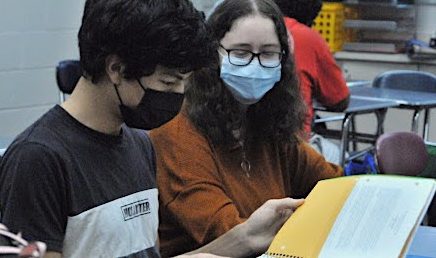Advisory Reboot Gets Slow Start
This year, Wilde Lake rebooted its Advisory program, a daily, 20-minute period to be used for community building, distributing materials, and giving information to students. But whether the program has been successful, really depends on who is asked.

Ms. Kelli Midgley, an Advisory committee member and an English teacher at Wilde Lake since 1995, says that historically, Advisory was the center of many school programs. Ms. Midgley says that Advisory is a layer of the support system needed to rebuild the school community after online learning.
But the community-building aspect that Advisory was designed for has been a challenge to develop due to lack of engagement, according to Mrs. Midgley.
Sophomore Abisola Ayoola says she enjoys the break in the school day but does not believe that her Advisory follows the original intention of community bonding. Ayoola says there is nothing for students and teachers to bond over in her Advisory because most students use the time to be on their phones. “More structure, like more specific roles for students and Advisors, with documents listing expectations for them,” is the key to student participation, she says.

Other students have had similar experiences. Sophomore Al Norman says they like the “interruption between classes” provided by Advisory. They say students need a break in the day where students “don’t have to learn or get graded.”
However, Norman says they neither bond with their peers nor participate in activities during Advisory. “[It’s time for students to] do their own thing and not have to worry about following teacher directions,” they said.
Teacher and Advisory co-chair Ms. Maria Romano-Sweitzer says that Advisory was designed to allow Wilde Lakers to get to know their community and gain new perspectives. “Part of Wilde Lake and being a teacher at Wilde Lake is community,” she said. “Being here means you’re part of the community.”
Freshman Victoria Goforth believes that Advisory does serve its purpose of allowing students to build relationships with other people. Goforth says she rarely looks forward to Advisory, but that “30 to 35 minutes would be the ideal [length of Advisory.]” She adds that opportunities to “play games and share interests” might change that.

But Mrs. Sweitzer says that Advisory isn’t always used for community-building. “Every day [in Advisory] is not a workday,” she said. “Advisory is also downtime.”
Sophomore Gabby Oshadiya says she wants more time in Advisory. “It’s one of my favorite times of the day,” she says. “If that break wasn’t there, I think I’d go insane.”
Oshadiya says a solution to the problem of engagement needs to come from both students and Advisors. “A lot of the people who criticize Advisory don’t approach it with growth mindsets and aren’t starting conversations. Someone has to speak,” she said. “You can’t complain about something you put no effort into.”
After two months of school, Ms. Midgley says she believes in Advisory. “In terms of building a whole cohesive community, it’s been slow,” she said. “But in the long run, it’s so worth it, and Advisory is so fundamental to the whole effort.”
Your donation will support the student journalists of Wilde Lake High School. Your contribution will allow us to purchase equipment and cover our annual website hosting costs.



